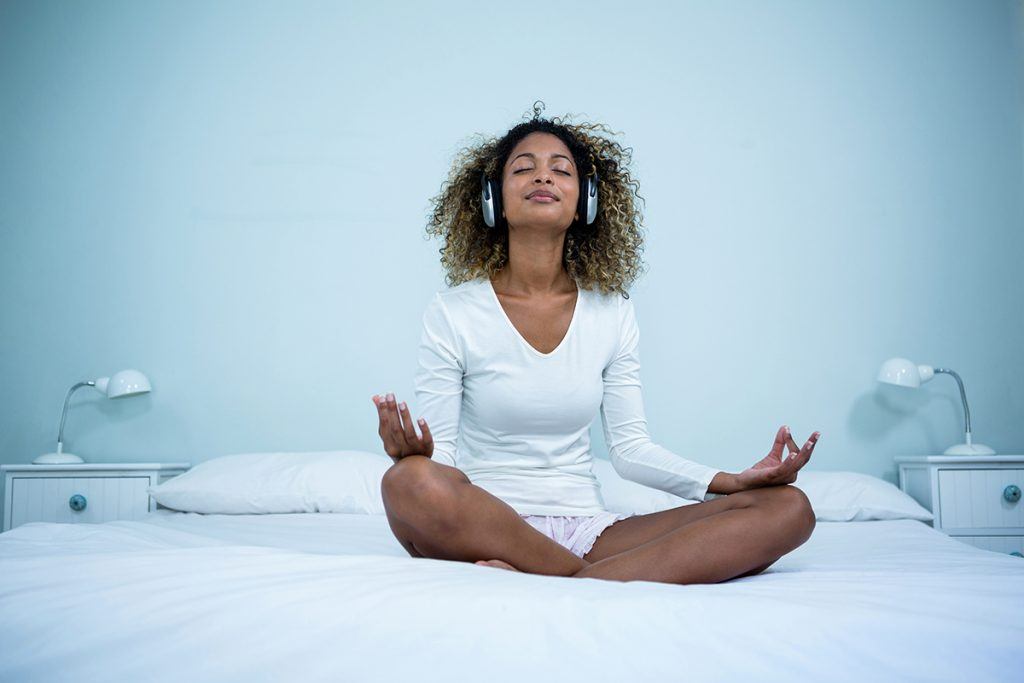Ever heard of sleep paralysis? It’s a sleep issue that affects around 3 million people each year, and it can be scary or unsettling. Basically, during sleep paralysis, the mind is awake but the body is not. People can breathe and see, but they cannot move or speak. This lasts from anywhere from a few seconds to a few minutes. Here’s what you should know about the condition.
Understanding Sleep Paralysis
When people enter a phase of sleep called REM sleep, their brain signals to their body that their voluntary muscles should relax and go into a paralysis-like state called atonia. This stops the body from “acting out” things that happen in the REM dreams like running, kicking and so on.

When sleep paralysis occurs, something goes haywire and one’s muscles remain in atonia, while their mind is awake and their eyes are open. According to WebMD, some people may feel a “choking” sensation or heavy pressure on their chest.
“It can be very scary when people are unable to move,” the American Academy of Sleep Medicine’s sleep education website explains. “People may feel anxious and afraid. Some people also hallucinate during an episode. They may see, hear or feel things that are not there. They may even think that another person is in the room with them. These hallucinations may also appear without the sleep paralysis.”
Types of Sleep Paralysis
Sleep paralysis tends to materialize in two forms. Here’s how they differ:
Recurrent sleep paralysis
This includes multiple episodes of sleep paralysis that occur at least twice in a six-month period, and it may require seeking out professional help.
Isolated sleep paralysis
As the name implies, isolated sleep paralysis is a singular episode that many people experience at least once in their lives. Generally, this type of sleep paralysis isn’t related to a medical problem.
Who Is Most Likely to Have Sleep Paralysis?
While the exact cause of sleep paralysis isn’t fully known, researchers have found that the following are linked to an increased risk:
- Not getting enough sleep
- Having an irregular sleep schedule (such as shift work)
- Mental stress
- Sleeping on your back
What Causes Sleep Paralysis?
Some medical conditions have been associated with sleep paralysis, including:
- Sleep disorders, such as narcolepsy
- Some mental health disorders like bipolar disorder, post-traumatic stress disorder (PTSD) and panic disorder
- Use of certain medicines, such as those for attention deficit hyperactivity disorder (ADHD)
- Substance use
- Dreams patterns, like lucid dreaming or nightmares
Symptoms of Sleep Paralysis
Sleep paralysis can manifest with a variety of symptoms, or just one or two telltale signs. These are the most common symptoms people may experience:
Paralysis in Your Limbs
While experiencing sleep paralysis, you’ll likely be aware of your surroundings, but can’t move or speak. However, you can still move your eyes and breathe. This paralysis in your limbs is temporary and resolves upon fully waking up.
Shortness of Breath
Shortness of breath is not uncommon during sleep paralysis, as episodes can leave you anxious and frightened. Some people may even find themselves gasping for air, but it’s important to remember that you’re still breathing.
Sense of Suffocation
Similarly, sleep paralysis may cause a sense of suffocation that some people liken to an elephant sitting on their chest, even if your breathing isn’t actually affected. Staying calm can help you keep your breathing steady.
Helplessness
Sleep paralysis can be frightening, especially if you’re unable to move, and those one or two-minute episodes can seem to last a lifetime. However difficult it may be, it’s essential to keep in mind that these episodes will eventually pass.
Sweating
As you wake up in a panic, it’s normal to sweat through episodes of sleep paralysis. This is often due to anxiety and will subside after waking.
Nausea
While less common, you might find yourself nauseous from sleep paralysis. After all, these episodes can be frightening and stressful, so it’s natural to feel a little sick after.
Inability to Speak
In addition to a feeling of paralysis in your limbs, many people going through sleep paralysis episodes aren’t able to speak until the episode passes.
Tips for Dealing With Sleep Paralysis
While sleep paralysis may leave you feeling helpless or scared, it’s a harmless condition that most people will only experience once in their lives. Still, sleep paralysis can lead to anxiety, and it may even be influenced by other conditions, like narcolepsy. To help you cope with sleep paralysis, try these lifestyle changes.
Creating a Calming Bedtime Routine
A consistent bedtime routine is an important component of sleep hygiene, which is a set of practices and behaviors related to your sleep. Adjusting your sleep schedule by going to bed and waking up at the same time each day can be a great way to get into a routine (and train your body to know when to sleep).

Depending on your interests, you may want to include other relaxing activities in your bedtime routine, such as taking a hot bath before bed, lighting candles or doing evening yoga or meditation. You can also try reading a book instead of watching TV or playing on your smartphone. This may help reduce blue light exposure, which can disrupt your sleep cycle.
Reducing Stress and Anxiety
Stress and anxiety are major precursors to sleep issues, so making it a point to reduce both may help prevent sleep problems. Stress reduction goes hand-in-hand with creating a calming bedtime routine. In addition to the ideas I shared above, getting regular exercise, lowering caffeine intake and journaling can all help reduce anxiety—and potentially improve your sleep.
Seeking Support from Online Communities
Sleep paralysis can feel isolating, but know you’re not alone. About 3 million people experience sleep paralysis each year, making it a common (but harmless) sleep condition. Seeking support from online communities dedicated to sleep paralysis can help you learn from other experiences, and can be a great way to share tips and strategies for coping.
Final Thoughts
While sleep paralysis can be scary, it has no long-term effects and is generally not a sign of any serious illness. Some people may experience it only once or twice, while others may experience it more regularly. According to the Mayo Clinic, sleep paralysis episodes can be common in people who have narcolepsy.
Most people won’t require treatment for sleep paralysis. But if it happens to you regularly, and it really disturbs your sleep, you should chat with your doctor.
FAQs
What triggers sleep paralysis?
While the exact roots of sleep paralysis aren’t known, researchers have found links to poor sleep, irregular sleep schedules, mental stress and back sleeping as potential precursors for sleep paralysis.
What happens during sleep paralysis?
During sleep paralysis, you may be unable to move or speak. You may feel shortness of breath or a heaviness on your chest, even if you’re actually while you’re breathing. These episodes are harmless and generally pass after one or two minutes.
How can I stop sleep paralysis?
There are no proven therapies to stop a sleep paralysis episode, but focusing on making small body movements (like moving one finger) can help an episode pass more quickly. In general, reducing stress and maintaining a calm and consistent bedtime routine can also help reduce the chance of sleep paralysis.

